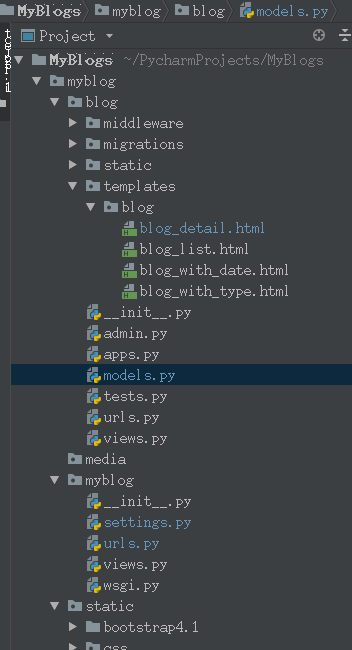使用django默认的编辑器感觉功能太少了,所以集成一下富文本编辑器。
1、安装和使用
(1)、安装
pip install django-ckeditor
(2)、注册应用
在django的settings中添加‘ckeditor’的app
(3)、配置models
将需要用到富文本编辑器的字段改成RichTextField
上面三步配置过后是不能上传图片的,下面配置上传图片的功能。
(4)、安装pillow库
pip install pillow
(5)、注册应用
添加'ckeditor_uploader'这个app
(6)、在settings指定图片上传的目录
# media MEDIA_URL='/media/' MEDIA_ROOT=os.path.join(BASE_DIR,'media') # 配置ckeditor CKEDITOR_UPLOAD_PATH='upload/'
(7)、在urls中指定要上传的网址
from django.contrib import admin from django.urls import path, include from django.conf import settings from django.conf.urls.static import static from . import views urlpatterns = [ path('', views.home, name='home'), # 主页路径 path('admin/', admin.site.urls), path('ckeditor', include('ckeditor_uploader.urls')), # 配置上传url path('blog/', include('blog.urls')), # 博客app路径 ] # 设置ckeditor的上传 urlpatterns += static(settings.MEDIA_URL, document_root=settings.MEDIA_ROOT)
(8)、配置model
把字段改成RichTextUploadingField字段类型
(9)、官方文档
上面这几步差不多就行了,还需要扩展功能,前往-》官方文档
2、变化的部分:

3、上代码

{# 引用模板 #} {% extends 'base.html' %} {% load staticfiles %} {% block header_extends %} <link rel="stylesheet" href="{% static 'blog/blog.css' %}"> {% endblock %} {# 标题 #} {% block title %} {{ blog.title }} {% endblock %} {# 内容#} {% block content %} <div class="container"> <div class="row"> <div class="col-6 offset-1"> <ul class="blog-info-description"> <h3>{{ blog.title }}</h3> <li>作者:{{ blog.author }}</li> {# 时间过滤器让时间按照自己需要的格式过滤 #} <li>发布日期:{{ blog.created_time|date:"Y-m-d H:n:s" }}</li> <li>分类: <a href="{% url 'blogs_with_type' blog.blog_type.pk %}"> {{ blog.blog_type }} </a> </li> </ul> <p class="blog-content">{{ blog.content|safe }}</p> <p>上一篇: {% if previous_blog %} <a href="{% url 'blog_detail' previous_blog.pk %}">{{ previous_blog.title }}</a> {% else %} <span>没有了</span> {% endif %} </p> <p>下一篇: {% if next_blog %} <a href="{% url 'blog_detail' next_blog.pk %}">{{ next_blog.title }}</a> {% else %} <span>没有了</span> {% endif %} </p> </div> </div> </div> {% endblock %} {% block js %} <script> $(".nav-blog").addClass("active").siblings().removeClass("active"); </script> {% endblock %}

from django.db import models from django.contrib.auth.models import User from ckeditor_uploader.fields import RichTextUploadingField # Create your models here. # 博客分类 class BlogType(models.Model): type_name = models.CharField(max_length=15) # 博客分类名称 def __str__(self): # 显示标签名 return self.type_name # 博客 class Blog(models.Model): title = models.CharField(max_length=50) # 博客标题 blog_type = models.ForeignKey(BlogType, on_delete=models.DO_NOTHING) # 博客分类 content = RichTextUploadingField() # 博客内容,使用富文本编辑 author = models.ForeignKey(User, on_delete=models.DO_NOTHING) # 博客作者 created_time = models.DateTimeField(auto_now_add=True) # 博客创建时间 last_updated_time = models.DateTimeField(auto_now=True) # 博客更新事件 def __str__(self): # 显示标题名 return "<Blog:{}>".format(self.title) class Meta: ordering = ['-created_time'] # 定义排序规则,按照创建时间倒序

""" Django settings for myblog project. Generated by 'django-admin startproject' using Django 2.1.3. For more information on this file, see https://docs.djangoproject.com/en/2.1/topics/settings/ For the full list of settings and their values, see https://docs.djangoproject.com/en/2.1/ref/settings/ """ import os # Build paths inside the project like this: os.path.join(BASE_DIR, ...) BASE_DIR = os.path.dirname(os.path.dirname(os.path.abspath(__file__))) # Quick-start development settings - unsuitable for production # See https://docs.djangoproject.com/en/2.1/howto/deployment/checklist/ # SECURITY WARNING: keep the secret key used in production secret! SECRET_KEY = 'ea+kzo_5k^6r7micfg@lar1(rfdc08@b4*+w5d11=0mp1p5ngr' # SECURITY WARNING: don't run with debug turned on in production! DEBUG = True ALLOWED_HOSTS = [] # Application definition INSTALLED_APPS = [ 'django.contrib.admin', 'django.contrib.auth', 'django.contrib.contenttypes', 'django.contrib.sessions', 'django.contrib.messages', 'django.contrib.staticfiles', 'blog.apps.BlogConfig', # 将自己创建的app添加到设置中 'ckeditor', 'ckeditor_uploader', ] MIDDLEWARE = [ 'django.middleware.security.SecurityMiddleware', 'django.contrib.sessions.middleware.SessionMiddleware', 'django.middleware.common.CommonMiddleware', 'django.middleware.csrf.CsrfViewMiddleware', 'django.contrib.auth.middleware.AuthenticationMiddleware', 'django.contrib.messages.middleware.MessageMiddleware', 'django.middleware.clickjacking.XFrameOptionsMiddleware', 'blog.middleware.mymiddleware.My404', # 添加自己的中间件 ] ROOT_URLCONF = 'myblog.urls' TEMPLATES = [ { 'BACKEND': 'django.template.backends.django.DjangoTemplates', 'DIRS': [ os.path.join(BASE_DIR, 'templates'), ], 'APP_DIRS': True, 'OPTIONS': { 'context_processors': [ 'django.template.context_processors.debug', 'django.template.context_processors.request', 'django.contrib.auth.context_processors.auth', 'django.contrib.messages.context_processors.messages', ], }, }, ] WSGI_APPLICATION = 'myblog.wsgi.application' # Database # https://docs.djangoproject.com/en/2.1/ref/settings/#databases DATABASES = { # 'default': { # 'ENGINE': 'django.db.backends.sqlite3', # 'NAME': os.path.join(BASE_DIR, 'db.sqlite3'), # } 'default': { 'ENGINE': 'django.db.backends.mysql', 'NAME': 'myblogs', # 要连接的数据库,连接前需要创建好 'USER': 'root', # 连接数据库的用户名 'PASSWORD': 'felixwang', # 连接数据库的密码 'HOST': '127.0.0.1', # 连接主机,默认本级 'PORT': 3306 # 端口 默认3306 } } # Password validation # https://docs.djangoproject.com/en/2.1/ref/settings/#auth-password-validators AUTH_PASSWORD_VALIDATORS = [ { 'NAME': 'django.contrib.auth.password_validation.UserAttributeSimilarityValidator', }, { 'NAME': 'django.contrib.auth.password_validation.MinimumLengthValidator', }, { 'NAME': 'django.contrib.auth.password_validation.CommonPasswordValidator', }, { 'NAME': 'django.contrib.auth.password_validation.NumericPasswordValidator', }, ] # Internationalization # https://docs.djangoproject.com/en/2.1/topics/i18n/ # LANGUAGE_CODE = 'en-us' # 语言 LANGUAGE_CODE = 'zh-hans' # TIME_ZONE = 'UTC' # 时区 TIME_ZONE = 'Asia/Shanghai' USE_I18N = True USE_L10N = True # 不考虑时区 USE_TZ = False # Static files (CSS, JavaScript, Images) # https://docs.djangoproject.com/en/2.1/howto/static-files/ STATIC_URL = '/static/' STATICFILES_DIRS = [ os.path.join(BASE_DIR, "static") ] # media MEDIA_URL='/media/' MEDIA_ROOT=os.path.join(BASE_DIR,'media') # 配置ckeditor CKEDITOR_UPLOAD_PATH='upload/' # 自定义参数 EACH_PAGE_BLOGS_NUMBER = 7

"""myblog URL Configuration The `urlpatterns` list routes URLs to views. For more information please see: https://docs.djangoproject.com/en/2.1/topics/http/urls/ Examples: Function views 1. Add an import: from my_app import views 2. Add a URL to urlpatterns: path('', views.home, name='home') Class-based views 1. Add an import: from other_app.views import Home 2. Add a URL to urlpatterns: path('', Home.as_view(), name='home') Including another URLconf 1. Import the include() function: from django.urls import include, path 2. Add a URL to urlpatterns: path('blog/', include('blog.urls')) """ from django.contrib import admin from django.urls import path, include from django.conf import settings from django.conf.urls.static import static from . import views urlpatterns = [ path('', views.home, name='home'), # 主页路径 path('admin/', admin.site.urls), path('ckeditor', include('ckeditor_uploader.urls')), # 配置上传url path('blog/', include('blog.urls')), # 博客app路径 ] # 设置ckeditor的上传 urlpatterns += static(settings.MEDIA_URL, document_root=settings.MEDIA_ROOT)
